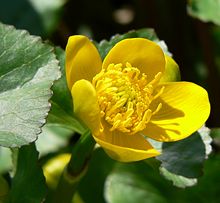Ranunculaceae
| Ranunculaceae | ||||||||||
|---|---|---|---|---|---|---|---|---|---|---|
 Caltha palustris
|
||||||||||
| Scientific classification | ||||||||||
|
||||||||||
| Subfamilies | ||||||||||
|
Ranunculaceae is a family of flowering plants also known as the "buttercup family" or "crowfoot family". The family name is derived from the genus Ranunculus. Members include Anemone (anemones), Ranunculus (buttercups), Aconitum (aconite), and Clematis.
According to the database of the Royal Botanic Gardens, Kew, the family consists of 51 to 88 genera, totalling about 2500 species. Numerically the most important genera are Ranunculus (600 species), Delphinium (365 species), Thalictrum (330 species), Clematis (325 species), and Aconitum (300 species).
Ranunculaceae can be found worldwide, but are most common in the temperate and cold areas of the northern hemisphere. The family contains many ornamental flowering plants common to the Himalaya, some of which are of medicinal value.
Contents |
Taxonomy
This family has been universally recognized by taxonomists, and the APG II system, of 2003 (unchanged from the APG system, of 1998), places it in the order Ranunculales, in the clade eudicots.
The cladogram below has been proposed in APG II system according to recent molecular phylogeny.
|
|||||||||||||||||||||||||
The genus Glaucidium was once put in its own family (Glaucidiaceae), but has been recently recognised as a primitive member of Ranunculaceae. Tamura (1993) recognised five subfamilies, mainly based on chromosomic and floral characteristics (Hydrastidoideae, Thalictroideae, Isopyroideae, Ranunculoideae, Helleboroideae).
Hydrastidoideae and Glaucidioideae have only one species, Hydrastis canadense and Glaucidium palmatum respectively. Coptoideae has 17 species and Thalictroideae has 450, including Thalictrum and Aquilegia. The other genera (2025 species, 81% of the family) belong to Ranunculoideae.
Some older classifications included Paeonia (peony) in Ranunculaceae but this genus is now placed in its own family, Paeoniaceae in order Saxifragales. Circaeaster and Kingdonia are now placed in Circaeasteraceae.
Description

Ranunculaceae are mostly herbaceous plants, but with some woody climbers (such as Clematis) and subshrubs (e.g. Xanthorhiza).
Leaves are very often more or less palmately compound.
The flowers of the Ranunculaceae show what are considered in some systems of plant taxonomy to be typically primitive characteristics, although the classification scheme of the Angiosperm Phylogeny Group considers this family to be among the most basal of the derived Eudicots clade. They are generally showy and medium to large in size in order to attract pollinators and are actinomorphic or radially symmetrical, although in some genera (e. g. Aconitum, Consolida) they are zygomorphic or bilaterally symmetrical. The perianth is made of one or, more commonly, two whorls, often not clearly differentiated into a true calyx and corolla, the sepals may be joined and the petals are often evolved into spurred nectaries or otherwise modified. The flowers have many free stamens arranged in spirals and usually many free pistils. Flowers are most often grouped in terminal racemes, panicles or cymes.
The fruit is most commonly a follicle (e. g. Helleborus, Nigella) or an achene (e. g. Ranunculus, Clematis).
Ranunculaceae contain protoanemonin, which is toxic to humans and animals. Other poisonous or toxic compounds, alkaloids and glycosides, are also very common.
Uses
Some Ranunculaceae are used as herbal medicines because of their alkaloids and glycosides, such as Hydrastis canadensis (goldenseal), whose root is used as a tonic.
Many genera are well known as cultivated flowers, such as Aconitum (monkshood), Consolida (larkspur), Delphinium, Helleborus (Christmas rose), Trollius (globeflower).
The seeds of Nigella sativa, are used as a spice in Indian and Middle Eastern cuisine.
Selected genera
|
|
|
Image gallery
References and external links
- Ranunculaceae in Topwalks
- Ranunculaceae
- Ranunculaceae in L. Watson and M.J. Dallwitz (1992 onwards). The families of flowering plants.
- Flora of North America: Ranunculaceae
- Flora of China: Ranunculaceae
- NCBI Taxonomy Browser
- links at CSDL, Texas
- Japanese Ranunculaceae - Flavon's art gallery
- Stevens, P. F. (2001 onwards). Angiosperm Phylogeny Website. Version 7, May 2006 [and more or less continuously updated since]. [1]
- (Italian) Sandro Pignatti, Flora d'Italia, Edagricole, Bologna 1982. ISBN 8850624492
- Tamura, M.: "Ranunculaceae.", en Kubitzki, K., Rohwer, J.G. & Bittrich, V. (Editores). The Families and Genera of Vascular Plants. II. Flowering Plants - Dicotyledons..- Springer-Verlag: Berlín, 1993.- ISBN 3-540-55509-9
- Strasburger, Noll, Schenck, Schimper: Lehrbuch der Botanik für Hochschulen. 4. Auflage, Gustav Fischer, Jena 1900, p. 459 (flower diagrams)